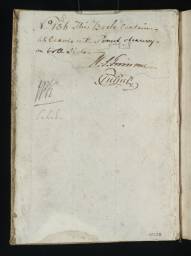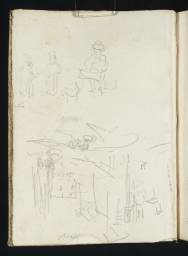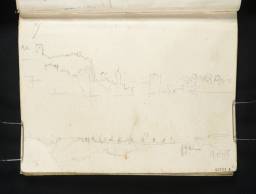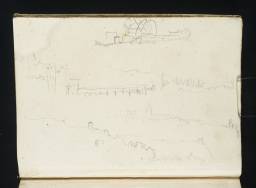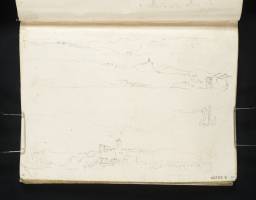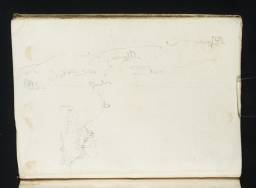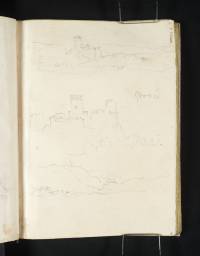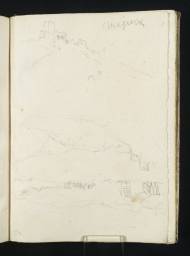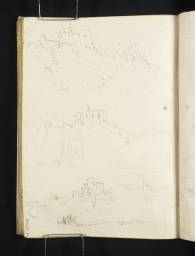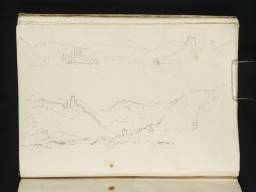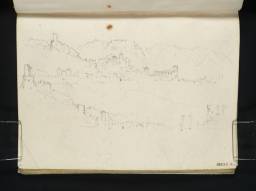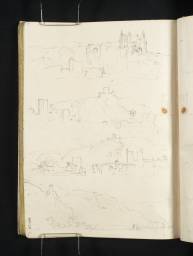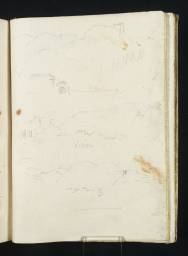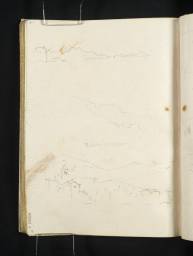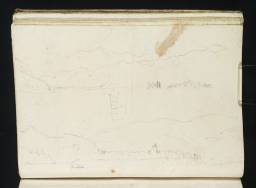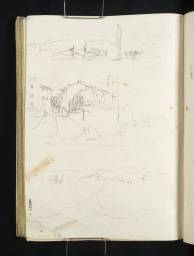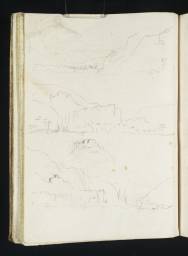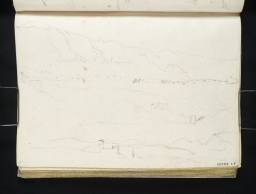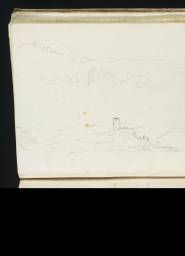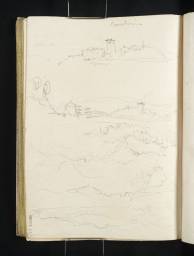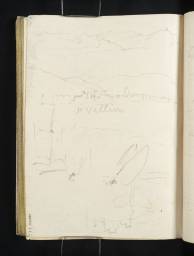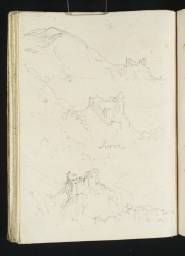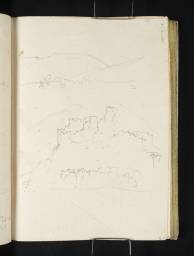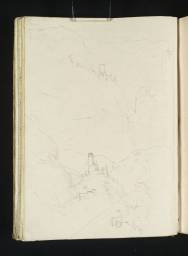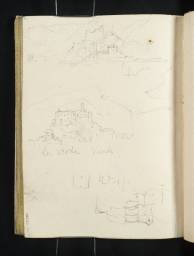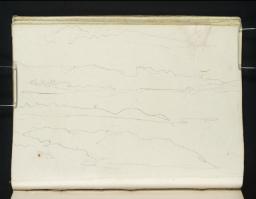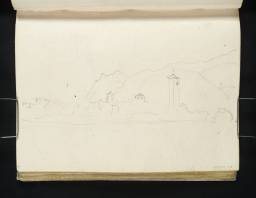Turner Bequest CCXXX 1–13a, 15–74a
Sketchbook bound in thin boards, covered in parchment; spine apparently replaced and rebacked with modern vellum
74 leaves and paste-downs of white wove paper, with edges washed in yellow; page size 145 x 111 mm
Possibly made by Jardel Mill at Couze, near Bergerac; no watermarks detected
Numbered 186 as part of the Turner Schedule in 1854 and endorsed by the Executors of the Turner Bequest inside front cover (D41001)
Stamped in black ‘CCXXX’ on front cover, bottom right, descending vertically
74 leaves and paste-downs of white wove paper, with edges washed in yellow; page size 145 x 111 mm
Possibly made by Jardel Mill at Couze, near Bergerac; no watermarks detected
Numbered 186 as part of the Turner Schedule in 1854 and endorsed by the Executors of the Turner Bequest inside front cover (D41001)
Stamped in black ‘CCXXX’ on front cover, bottom right, descending vertically
Accepted by the nation as part of the Turner Bequest 1856
Exhibition history
References
Turner used this sketchbook during his second major tour of France and Italy in 1828–9, as one of eight associated with this journey (see the overall tour Introduction). Chronologically, it is the first sketchbook of the tour, documenting an early phase of his journey through southern France before entering northern Italy via Genoa. Very little is known about Turner’s route to Lyon from London, although he evidently travelled via Paris, where he wrote ahead to his friend Charles Eastlake in August, requesting the preparation of canvases for his arrival in Rome that autumn.1
While Turner could have taken an alternative route to Rome by crossing the Alps, as he had done in 1819 (see Nicola Moorby’s section in the present catalogue), he developed instead an itinerary that took him via southern France. As Cecilia Powell noted in Turner in the South, this revised route introduced him to new places and experiences; ‘he was obviously very interested in the south of France for its own sake and it is worth noting that many travellers regarded the Roman remains there as superior even to those in Rome itself.’2 Turner’s sketches of Nîmes, especially, reflect his longstanding interest in the grand monuments of antiquity.3 Turner’s detour via southern France caused him significant delays, increasing his journey time. As he conceded to George Jones in a letter from Rome on 13 October 1828, ‘the length of the time is my own fault. I must see the South of France, which almost knocked me up, the heat was so intense, particularly at Nismes and Avignon; and until I got a plunge into the sea at Marseilles, I felt so weak that nothing but the change of scene kept me onwards to my distant point.’4
Initially, two additional sketchbooks, Orleans to Marseilles and Coast of Genoa, were thought to relate to this tour (Tate; Turner Bequest CCXXIX, CCXXXII), as they cover a similar geographical terrain. However, following further research by Turner scholars including Ian Warrell and Roland Courtot, they have since been reallocated to a later journey through southern France and Italy in 1838.5
Finberg’s 1909 Inventory of the Bequest tended to assign generic titles to the works in this sketchbook, most of which have been revised in the present catalogue with more precise identifications. The author is indebted to geographer and Turner researcher Roland Courtot, who has written extensively on Turner’s travels in France in a series of articles and online blogs.6 Many of the identifications in the present sketchbook would not have been possible without his encyclopaedic knowledge of the local topography. In Courtot’s assessment, three distinctive qualities characterise Turner’s sketchbooks from southern France: the precision of the topographical analysis; the ‘monumentalisation’ of ports and urban buildings; and the ‘kinetic interpretation’ of the landscape through multiple drawings documenting his shifting perspective.7
The title of the present sketchbook, as assigned by Finberg, is ‘Lyons to Marseilles’. However, this does not quite align with the scope of its contents: Lyon does not seem to feature in the sketchbook, and Vienne is among the earliest identifiable locations, just south of Lyon on the left bank of the Rhône. The sketchbook concludes with studies of the port city of Toulon, which lies beyond Marseille on the route towards northern Italy.
This is a sketchbook of two halves, which can be better understood in terms of Turner’s changing mode of transport. Overwhelmingly, the first half of the sketchbook encompasses views from the artist’s two-day boat journey along the Rhône from Lyon to Avignon: see folios 2 recto to 39 verso (D20992–D21065; Turner Bequest CCXXX 2–38a). As Courtot observed, Turner took a great interest in rivers, an inexhaustible source of landscape studies as well as the axes of circulation and settlement during a period when navigation was advancing from sail to steam.8 Over the course of his journey, Turner passed numerous villages, towns and ruins bordering the river, which he recorded in a profusion of swift sketches, often combining three or four topographical studies on a single page. Vienne, Serves-sur-Rhône, La Voulte-sur-Rhône, Viviers, Rochemaure, Bourg-Saint-Andéol, Pont-Saint-Esprit and Châteauneuf-du-Pape particularly caught his eye, often due to their magnificent bridges or imposing castles in various states of romantic ruin: see, for example, folios 12 verso and 33 recto (D21013, D21052; Turner Bequest CCXXX 12a and 32).
There are many parallels between the present sketchbook and the 1838 Orleans to Marseilles sketchbook (Tate; Turner Bequest CCXXIX), which covers much of the same geographical terrain. However, as Courtot observed, Turner travelled by steamboat on this later journey, a more technologically advanced mode of transport that halved the two-day journey time of his 1828 route from Lyon to Avignon.9 Despite its time-saving benefits, this reduced journey time also decreased the number of hours he could devote to sketching. Consequently, the present sketchbook tends to include more detailed studies.
Sketching from a boat in motion presented challenges and opportunities in equal measure. Following the natural current of the river, Turner observed striking topographical and architectural features of the landscape – ruined castles, villages, rock formations and bridges – from varying angles and distances. But he also needed to work under pressure and with great speed and economy, often resorting to swift, schematic sketches to record the necessary details before the subject disappeared from view. Sketching from a moving boat, he could not deviate from the prescribed route, nor alter the pace of travel.
A recurring feature of the first half of the sketchbook, Turner tended to create multiple profiles of a riverside landmark, such as a ruined castle. He first captured the view from upstream, then to the side, and finally from downstream, looking back. Such examples can be found intermittently between folios 12 verso and 33 verso (D21013, D21029, D21037, D21041, D21052–D21053; Turner Bequest CCXXX 32 and 32a).
Disembarking from the boat at Avignon, likely in early September 1828, Turner adapted his sketching methods accordingly as he travelled between cities by carriage and traversed their streets on foot. The latter half of the sketchbook focuses predominantly on Avignon (see folios 40 recto–43 recto, D21066–D21072; Turner Bequest CCXXX 39–42); Nîmes (see folios 44 verso–48 verso and 49 verso, D21075–D21083, D21085; Turner Bequest CCXXX 43a–47a and 48a); Marseille (see groupings between folios 53 recto and 66 recto; D21092–D21114, D21117–D21118; Turner Bequest CCXXX 52–63 and 64a–65); and Toulon (see intermittently between folios 65 recto–74 recto; D21116, D21121, D21123, D21128–D21129; Turner Bequest CCXXX 64, 66a, 68, 72a and 73). With their ancient Roman heritage and their lively maritime culture, these cities held considerable appeal for Turner. He was particularly captivated by the old port at Marseille, which features on twenty-seven pages towards the end of the sketchbook, more than any other location.
While the contents of this sketchbook broadly follow the chronological order of Turner’s route, many examples fall outside this itinerary. There are two likely explanations for this. Eager to document the changing scenery, Turner may have retrieved the sketchbook from his pocket with such haste that he opened it at random, filling the first available space he could find. Alternatively, the misalignment might be attributable to John Ruskin’s intervention when dismantling the sketchbook, causing the pages to be incorrectly ordered when the sketchbook was rebound at a later date (see the technical notes).
The overall appearance of the sketchbook is haphazard at times, with many pages featuring dense compositions of multiple, overlapping sketches, occasionally with four or five topographical profiles clustered together on a single page. Turner also moved freely between different sketchbook orientations, rapidly assessing whether to hold the book horizontally for a more panoramic presentation, or to keep it upright or upside down. For economy, he sometimes extended a vista across a double page spread, or spliced it in half across two halves of the same page and labelled it ‘1’ and ‘2’. See, for example, folio 54 recto (D21094; Turner Bequest CCXXX 53); folios 60 verso–61 recto (D21107–D21108; Turner Bequest CCXXX 59a–60); folio 1 recto (D20990); folio 21 verso (D21031); and folio 36 verso (D21059; Turner Bequest CCXXX 35a).
John Gage, Collected Correspondence of J.M.W. Turner with an Early Diary and a Memoir by George Jones, Oxford 1980, pp.118–8 no.140.
For an account of this reallocation of the sketchbooks between the two tours, see Roland Courtot, ‘5. Dates et itinéraires des carnets de Turner à travers le sud-est de la France’, Carnets de voyage de Turner, accessed 29 January 2024, https://carnetswt.hypotheses.org/517 . See also Courtot 2016, pp.95–6.
Roland Courtot, ‘6. Le carnet du voyage de Turner de Lyon à Marseille (CCXXX) (1–3)’, Carnets de voyage de Turner, accessed 29 January 2024, https://carnetswt.hypotheses.org/517 .
Roland Courtot, ‘William Turner de Lyon à Gènes Géographie des sites, architecture et cinétique des volumes au long de l’itinéraire’, accessed 2 February 2024, https://amu.hal.science/hal-01715968 .
Roland Courtot, ‘Turner et le Rhône, des carnets “géographiques”’, accessed 29 January 2024, https://amu.hal.science/hal-02875532 .
Technical notes
How to cite
Hannah Kaspar, ‘Lyons to Marseilles Sketchbook 1828’, sketchbook, November 2024, in David Blayney Brown (ed.), J.M.W. Turner: Sketchbooks, Drawings and Watercolours, Tate Research Publication, February 2025, https://www

